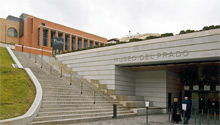Carlos Fernández de Henestrosa: Assistant Administration Manager of the Museo del PradoMISCELLANEOUS
Carlos Fernández de Henestrosa was born in Nice in 1949, is an economist and has held several positions, the one immediately before his current duty being that of Managing Director of the Museo Thyssen-Bornemisza which he held for 11 years.
Can you give us a potted history of the
Museo del Prado? Approximately how
many works are exhibited and how many
stored in its vaults? What budgetary, technical
and human resources does it have?
The Museo del Prado is a public organisation
attached to the Ministry of Culture.
Created in 1819 as the Real Museo de Pinturas
y Esculturas (Royal Museum of Painting
and Sculpture) at the initiative of Fernando
VII, the current Museo Nacional del
Prado includes a collection of approximately
7,000 paintings, 1,000 sculptures, 3,000
prints and 6,400 drawings, as well as an
extensive number of decorative objets d’art
and historic documents in a space of
approximately 60,000 square metres. Approximately 1,000 of the most outstanding
works are currently being exhibited. In the
near future, it is planned to expand the permanent
collection to about 1,500 works exhibited.
There is also a large part of the
museum’s stock, approximately 3,200 works,
being held in other State institutions and official
organisations. It should be remembered
that the works being exhibited do not include
any belonging to the major collections of
drawings and prints built up by the Prado
because these types of works cannot be exhibited
on a regular basis due to their fragile
conservation conditions.
More than 400 people work in the Museo del
Prado performing a variety of duties ranging
from guarding the works to research work, via
conservation and restoration, as well as various
administrative and management activities. The
budget for 2009 is more than 46 million Euros
and in terms of technical resources it has the
necessary resources to perform the numerous
activities it carries out paying special attention
to any new technologies that may be relevant
to the Museum.
Is it still the most visited place in Spain?
Of course, it is the most visited museum in
Spain but there is no logic in comparing the
number of visitors received by the Prado with
those received for example by the Alhambra –
a palace complex - or the Sagrada Familia – a
church -, although they are also two of the most
visited tourist destinations in Spain.
How significant is the first paragraph of the ICOM
(International Council of Museums) Code of
Ethics to the Museo del Prado: “Museums ensure
the protection, documentation and promotion of
humanity’s natural and cultural heritage”?
The mission of the Museo del Prado expressed
in Article 3 of the law which governs it, under
the heading “objectives and purposes” practically
matches what was stated in the previous
paragraph, although it also says that it must
ensure the collections are properly exhibited,
provide easy access to the public and researchers,
promote educational programmes and
train specialist personnel, as well as provide
scientific advice to the competent Government
bodies.
What do the security plans cover?
Like other great world museums, the Prado
has a security committee or group of experts
consisting of in-house and external professionals
who carry out a risk management process,
beginning by identifying, analysing and
assessing all those risks relating to the security
of the assets, contents and people working
there. The answer to this question may seem
brief but I cannot go into further detail. All I
can tell you is that the museum has the personnel
resources and appropriate technology
to guarantee the security of the people and
the items in its care.
Could you estimate the value of the contents
of the Museum?
The value of the works is incalculable and
bearing in mind their singular nature, it would
be impossible to replace them. No one would
have the temerity to put a figure on the value
of the contents.
What insurance do you have?
The works in the Museo del Prado are insured
whenever it is necessary to move them outside
the museum, whether for temporary exhibitions
or for any reason in connection with their
conservation. The insurance is always All Risks
on a “nail to nail” basis. The figure can be
between 60 and 70% depending on the type of
exhibition. Obviously, taking out the insurance
is down to the institution organising the exhibition.
The security of the works while they are being
moved is assured by the State Police who are
obliged to escort them to their destination.
What transport insurance cover is used or
required?
It depends on circumstances, but the usual
form is private insurance and State Insurance
or a combination of both.
How does restoration affect the value of the
paintings?
Bearing in mind that the works are not valued,
the restoration process cannot change the
value.
Is the refurbishment of the Museo del Prado
completely finished or are there still relevant
projects under way?
The Salón de Reinos (Royal Salon) is the most
relevant project for the Museo Nacional del
Prado, although the restoration of certain areas
in the Edificio Villanueva and the Casa de los
Águila in Ávila is worthy of mention.
What major claims have there been over the
last few years?
Practically none.



